How Does Arriving Feel? Modulating a Cinematic Sense of Commonality
TRANSIT vol. 11, no. 1
Hauke Lehmann
Abstract
The essay begins by identifying basic problems in current research on so-called “Turkish-German cinema.” It argues that current research is dominated by a representational understanding of the cinematic image which produces false conclusions regarding the relation between cinematic images and social reality, and that “Turkish-German cinema” has primarily been treated as a separate genre without due problematizing or concrete grounding in theory. Proceeding from this diagnosis, the essay develops a conceptual perspective which aims at theoretically realigning the relation between migration discourses and audiovisual media production. This project works along two lines: the methodological line aims at closely analyzing cinematic form with regard to its expressive dimension, while the theoretical line understands cinematic images as appropriations of globally circulating forms and patterns. This dimension of audiovisual discursivity has to be reconstructed analytically before films can be read as negotiations of cultural identity. These methodological and theoretical considerations are applied through the close analysis of the film Almanya – Welcome to Germany.
Acknowledgments
Many thanks to the editors and reviewers, whose comments and suggestions helped to improve this essay!
Introduction
Consider, if only for a moment, the possibility that “Turkish-German cinema” does not exist. How would we view films like 40 m² Deutschland (40 square meters Germany, Tevfik Başer 1985), Dealer (Thomas Arslan 1999), or Auf der anderen Seite (The Edge of Heaven, Fatih Akın 2007), without this unifying category? Why do we categorize these and other films under labels such as “Turkish-German cinema,” “accented cinema” (Naficy 2001), “cinéma du métissage” (Seeßlen 2000), or “cinema of double occupancy” (Elsaesser 2005, 118)?[1]
This question touches on the theoretical relation between aesthetics and politics. In this regard, it seems fairly obvious to suggest that our ideas about migration are thoroughly mediated. This is not only the case for those of “us” who have not migrated ourselves, but also for those who have. The history of migration is closely intertwined with the migration of images and sounds: For those who left home, home became an amalgam of music assembled on cassettes, of photographs, and of old movies rented on VHS cassettes from the local video store. It became a historical space of experience that can not only be shared with others but also be used to position oneself in all degrees of consensus and dissent with regard to a “foreign,” hegemonic audiovisual culture, forming (imaginary) communities based on aesthetic judgment.
As uncontroversial as this account may seem, it results in a decidedly different answer to the above question about Turkish-German cinema than that which is usually provided. The tension between these two approaches is not easily resolvable, and its negotiation forms the backdrop for the essay which follows. The two approaches differ not only in their understanding of cinematic experience, but also in their conceptualization of the political. The relay between both dimensions is marked precisely by the term “Turkish-German cinema.”
Confronted with the above questions, the predominant (if often implicit) answer provided by film and media scholars is that these films are grouped under the label of “Turkish-German cinema” because they form a genre which is concerned with Turkish-German history, culture, and identity. Thus, the term “Turkish-German cinema” involves both an aspect of comparison and the claim that the films under comparison are politically significant insofar as they relate to this particular aspect. My intention is to demonstrate that this answer is doubly misleading—both in implicitly presupposing a certain idea of genre and in tying this idea to a concept of identity. In its place, I want to sketch out another way to explore the political significance of these films by describing them as reconfigurations of a specific “sense of commonality” (Rorty 1998, 101).
Rather than speculating about a presupposed, shared experience of migration somehow translated into movement-images, I proceed from an analysis of the affective experience enabled by the films which shapes our ideas about what migration might be and what it might feel like. I exemplify this approach by analyzing a number of scenes from Almanya – Willkommen in Deutschland (Almanya – Welcome to Germany, Yasemin Şamdereli 2011). On the one hand, I describe the experience of watching the film in terms of an affect dramaturgy—a sequence of affective intensities experienced by the spectators. On the other, I show how this dramaturgy is linked to the circulation of audiovisual patterns from silent film comedy, European arthouse, road movies, and Turkish melodrama. I locate the political significance of the film at the intersection of these two levels: The film not only stages migration as an affective experience, but in doing so, provokes an aesthetic judgment by the audience. This judgment concerns the extent to which the film’s depiction of the world can align the individual spectator’s aesthetic pleasure with a commonly shared sense of the world. It positions the individual spectator with regard to a “sense of commonality” which, according to Richard Rorty, forms the basis for any kind of political community (1998). From this perspective, the question of politics becomes inseparable from the question of aesthetic experience—it is no longer predicated by the problem of identity, a problem which remains the primary focus of most researchers.
Migration Discourse and Audiovisual Media Production: The State of Research
Characteristically, films labeled as Turkish-German are viewed under a representational paradigm. According to this paradigm, the problems that fictional characters are faced with point to real-life struggles (cf. Naficy, Fincham 2008). The films comment (or fail to comment) on these problems; they mirror social and cultural developments (cf. Berghahn 2009). In short, they negotiate questions of living together on the level of plot and narrative (cf. Burns 2007, Rings 2008). The questions they address are of the kind posed time and again in discourses on migration: questions about identity, integration, or belonging (cf. Neubauer 2011, El Hissy 2012). These films ask such questions through fictional characters who are read according to biographical, cultural, or religious attributes as German, Turkish, or Turkish-German (cf. Seeßlen, Prager 2012). The films are then judged by how carefully they reproduce discursively pre-established images of being German or being Turkish (cf. the debate on “cinema of duty” vs. “cinema of hybridity” initiated by Göktürk 2000). Thus, in one way or another, the definition of Turkish-German (or “Turkish German” without the hyphen) cinema derives from “the history of postwar migration and the politics of social, political, and legal integration that found expression in the first wave of films about Turkish Germans that continue to inform the filmic imagination in the new millennium” (Hake & Mennel 2012, 2).
There are two reasons why such a conceptualization of Turkish-German cinema is problematic. Firstly, the theoretical problem is that this manner of thinking is based on the assumption that it is possible to extract fictional characters as independent entities from the moving image and to compare them with pre-filmic realities. If this assumption were true, we could easily separate form from content, treat films as texts, and attempt to isolate what they are saying. But films do not “say” anything. If we want to assess how films speak to social and political realities, we have to take into account how they address their audiences—a question of aesthetics. In this regard, it is not sufficient to equate movement-images with propositional statements. It seems more adequate to think of them as providing a means of seeing and hearing, and a means for making spectators see and hear (Sobchack 1992). Second, the political problem is that this idea of representation is based on the assumption that the films refer to a fixed, universally shared, and unmediated knowledge of what the reality and history of Turkish-German social relations looks like. If this assumption were true, films could never be critical of society. They would be condemned to reproduce all the stereotypes, all the misconceptions, and all the prejudices present in social discourse (cf. Horkheimer & Adorno 2003, 134–135). Scholars would have no choice but to look for and—thereby themselves—reproduce preexisting racist stereotypes.
The predominant conception of “Turkish-German cinema” implies presuppositions about identity politics that it generally does not account for (cf. the critique by Abel 2012). If we presuppose the possibility of reading the films on their level of representation, we say that there is no difficulty in knowing what is German and what is Turkish. We no longer ask ourselves how we arrive at those notions, but take them for granted. The basis for our thinking is then not the intersection of politics and aesthetics, but the implementation of preconceived concepts. If we do not want to reduce the films to objects of critique for such identity politics, but rather aim to unfold their own critical capacity, we need to relate them to current debates on migration and community in another way.
The overall programmatic aim of the approach exemplified in this essay consists of adjusting the theoretical relation between discourses of migration and audiovisual media production. In order to conceive of this relation, we need to account for how the films situate themselves in a world where images of migration circulate. How do they deal with external attributions and stereotypes? In Almanya, I will analyze a film that was received as being almost paradigmatically “Turkish-German” because it seemed to address the current debate on migration and integration head-on (cf. Sadigh 2011). This makes it a test case for the approach which I am advocating. Instead of predetermining norms to measure the films by, I propose deriving heuristic categories from an analysis of the films themselves. Specifically, in analyzing Almanya, I will describe several instances of a scenic pattern that might be called “arriving” or “encountering the unknown.” This scenic pattern serves as an intersection tying the affective experience of spatiotemporal relations (the tension produced by the staging of an encounter) to the unfolding of a fictional world (where this tension is projected onto the characters and the narrative they are involved in).
Before I can begin with the analysis, however, three preparatory steps are necessary: the first one introduces the concept of “mode” and “modality” as a basis for the affective involvement of spectators. Almanya’s affect dramaturgy, for example, is built on very pronounced modal shifts which structure the nature of the audience’s involvement over time. The second step builds on this and aims at unfolding the theoretical potential inherent in the encounter between screen and audience. This potential is then concretized in step three, as the concept of “tactical appropriation” is introduced—a poetic principle clearly at work in Almanya. The three steps together make the case for a rejection of the representational approach and lay the groundwork for examining the political significance of the film in more detail.
Modalities and Genres
Vivian Sobchack describes cinematic images as enacting ways of perceiving which in turn mediate the way in which we perceive the world (1992). They accomplish this through their realization in the bodily experience of spectators. But distinct relations between the general and the specific must precede this perception. This is why film analysis cannot jump directly to the level of representation. The (cinematic) apriori of appearing is a perspective, a specific way of perceiving: a mode or modality. Grotkopp and Kappelhoff define modalities as “specific aesthetically organised forms of experiencing and perceiving the world” (31). Christine Gledhill observes that a modality “organises the disparate sensory phenomena, experiences, and contradictions of a […] society in visceral, affective and [in the case of melodrama] morally explanatory terms” (228–229). Applied in this sense, the concept of modality not only helps to explain how fictional worlds can be experienced, but also how films might intervene politically by re-describing the limits of commonality: recasting the arrangement of inclusions and exclusions which determine what becomes perceivable in terms of a shared sense of the world.
Here, the question of genre comes into play insofar as we can tentatively understand genres as actualizing and combining different modes of appearing of cinematic worlds. Gledhill describes modality as “the sustaining medium in which the genre system operates” (223). This short definition has its implications for any question of commonality: It seems obvious, for example, that the melodramatic mode actualizes a very different way of perceiving the world than the modes of comedy, horror, or the thriller. To simplify radically: The melodramatic mode works towards turning the world of outward experience into an image of a psychic interior, emphasizing each nuance of affective sensation, while comedy tends to distance the viewer from experiences of bodily and psychological pain. With these different ways of perceiving come different divisions and relations between “us” and “them,” between that which does and does not belong, between what people are and are not capable of, between that which we can and cannot be asked to tolerate. Consequently, modalities have appeared in a wide range of different historical and cultural constellations and disguises. Modality “provides the genre system with a mechanism of ʻdouble articulation,ʼ capable of generating specific and distinctively different generic formulae in particular historical conjunctures, while also providing a medium of interchange and overlap between genres” (Gledhill 229). As I will show in and after my analysis, the question of genre is crucial to the theoretical framework I propose. Therefore, a more detailed discussion of this concept, which has been used implicitly in previous research, will be the focus of my conclusion. To prepare the methodological implementation of this approach in my analysis, I will now attend to the way cinematic image and audience come into contact with one another—an aspect which is often overlooked in the study of migration cinema in favor of a critique of representation.
Encounters between Screen and Audience
The concept of mode or modality addresses a key concern regarding my disagreement with much of the extant research on Turkish-German cinema: Before we can discuss what is represented on the screen, we have to take into account how it appears in our perception. If we ignore this aspect, we only have at our disposal the concepts we already brought into the cinema with us, and which we then find represented—more or less accurately—before us. In order to allow for a film to challenge or undermine our preconceived ideas about the world, we must analyze cinematic form on its own terms. This means, first and foremost, in its connection to the perception of the spectators.
The cinematic movement-image is present not as an object but as a temporal process of linking movement-image and the audience’s lived-bodies. Hence, if we focus on the aspect of temporality, we focus on everything that is not (yet) captured under the regime of representation. From this perspective, film cannot be separated from acts of perceiving, feeling, and thinking embodied in concrete spectators because film, according to Sobchack, is itself an act of seeing and hearing, realizing itself in the seeing and hearing of its spectators as an “alien mode of perception” (Bakels, Kappelhoff 86). This realization takes place as a temporal unfolding on the micro-level of concrete affect dramaturgies, that is, related to a sequence of affective intensities which spectators pass through when they watch and listen to a film (cf. Kappelhoff 2008, 30–31).
These dramaturgies in turn are linked to the process of fictionalization—to the construction of cinematic worlds taking place with each new shot. These two dimensions of cinematic temporality continually refer to one another without being reducible to either one or the other. Due to this reciprocal entanglement, cinema can be better understood as an “aesthetic mode of experience in which the affectivity of an individual lived-body is linked to the cultural registers of world-interpretation” (Kappelhoff 2007, 297). In turn, each act of film viewing relates every aspect of production intentionality to the activity of concrete spectators, who are bodily present before the screen. Only this relational nexus can be addressed as a cinematic image in the full sense of the term.
This also means that the act of film viewing cannot be separated from its social, cultural, and historical setting, mediated as a shared context of aesthetic experience. Thus, the questions central to a politics of identity—what is Turkish, what is German, and what is Turkish-German? —do not have an objectifiable addressee because the cinematic image is neither a text nor a statement that can be viewed independently of its context of appearance. This is why such questions cannot be determined prior to the act of film viewing, and their answers are constantly produced anew. If we understand cinematic images in this way—as emerging from a nexus of entangled acts of perception—we arrive at a new notion of audiovisual discursivity: not the usual markers of intertextuality such as quotations, homages, or pastiches, but a more fundamental dimension where cinematic images always already situate themselves with regard to the experience of other sounds and images. I address this dimension by referring to the concept of “tactical appropriation.”
Tactical Appropriation
If one looks at the films which are routinely grouped together as Turkish-German cinema, one recognizes that they interact with each other and with hegemonic contexts which constitute their aforementioned historical settings. These interactions can be understood as different ways of relating divergent positions to dominant cultures. A useful concept to describe this relation is what Michel de Certeau (1988) deems “appropriation.” Appropriation identifies precisely the encounter between a hegemonic culture and cultural productions potentially deviating in one way or another from this hegemony. This makes it possible to study the aforementioned films without engaging preconceived attributions or definitions of identity: appropriation does not presuppose a mimetic relationship to social reality. All it presupposes is a reservoir of audiovisual forms and expressive patterns which provides the opportunity to position oneself in relation to this context.
The following film analysis pursues two goals: On the one hand, I describe the affect dramaturgy of scenes: the sequence of affective intensities passed through by all spectators. On the other hand, this affect dramaturgy is reconstructed as an act of poetically situating itself with regard to a dominant audiovisual economy. I analyze how the film appropriates popular genres and expressive patterns to provide an affective experience to its audience. Building off of de Certeau, I conceive of this dimension of appropriation as a “poiesis” of media consumption: an act of bringing forth images. It is this interplay which constitutes a larger discourse of audiovisual images devising, articulating, and problematizing positions of participating in communities. The question Almanya feeds into this audiovisual discourse is “What does arriving feel like?” By posing this question, Almanya inserts itself into the circulation of images about migration. At the same time, the film enables spectators to define a position by making an aesthetic judgment. This judgment (at first nothing more than the expression of liking or disliking) concerns the extent to which spectators feel recognized in their particularity, in their individual experience. How the film addresses this multitude of experiences will be the topic of my analysis.
Analysis: Arriving as Encountering the Unknown
Questions of migration and belonging are clearly central to Almanya – Welcome to Germany. The film contrasts the “official” version of the history of Turkish guest workers in Germany with the story of a specific, concrete guest worker family. One is a story of harmony, while the other is a story of misunderstandings. The impression of harmony is conveyed primarily via the use of documentary footage demonstrating the success of Turkish-German cooperation; the misunderstandings are staged primarily through the mode of comedy.
With regard to this binary structure, the film inverts perspectives on the level of language: the Turkish characters speak German, while the German characters speak a kind of gibberish reminiscent of Chaplin’s speeches in The Great Dictator (1940), a film which on the one hand is used to reference Germany’s National Socialist past as a power structure of authority and obedience and, on the other hand, to evoke the idea of Western culture as a community of humanist values. Thus, the film does not employ references simply to construct a postmodern palimpsest, but to mediate different ways of being together as experiential qualities. The sometimes harsh ambivalence of these images of community is at the core of the film’s poetic logic. Through these associations, Almanya addresses a shared space of reference, where the possibility of community includes the audience of the film insofar as they feel recognized and able to take part in the construction of this space.
The film narrates a Turkish-German family’s vacation from Germany to a house the grandfather, Hüseyin, bought in Turkey. Their road trip is interrupted several times by flashbacks which relate the chronicle of Hüseyin, his wife, and children migrating to Germany and attempting to establish a new home there. The first scene I want to analyze is one such flashback which depicts the grandfather’s arrival in Germany. The scene begins as Hüseyin exits a train and walks through a tunnel at the end of which a bright light is shining—evoking visions of death or (re-)birth (Fig. 1).
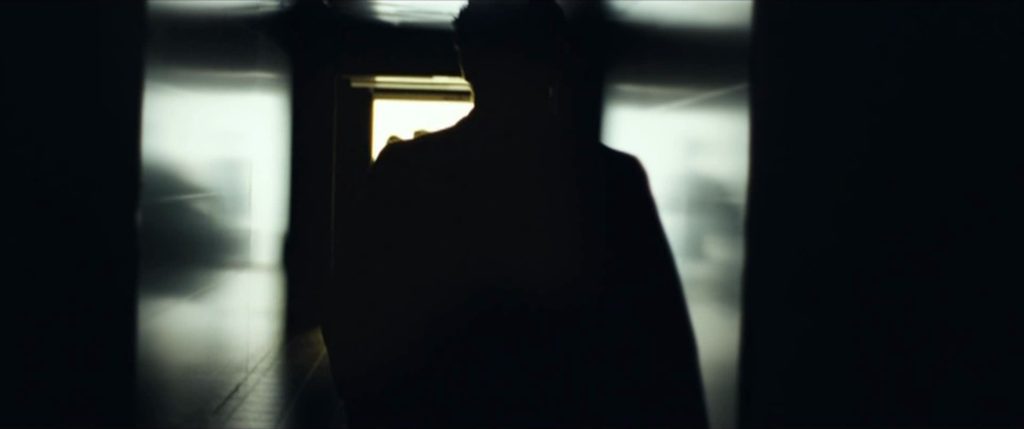
Throughout this scene, his granddaughter, Canan, who narrates the story in the present, speaks in voiceover. She tells how everything was “different” when Hüseyin came to Germany—especially the language. The moment that Hüseyin exits the tunnel and steps into the light is emphasized by a circling camera movement which identifies the sun as the source of the light. The near abstract composition of the walk through the tunnel yields to a slightly overexposed palette of greys and browns. These colors mark not only the historical setting of the flashback but also establish its contrast to the greens and yellows dominating scenes set in Turkey. At the same time, the climactic dramaturgy of moving towards the light is undercut and reduced to anticlimax by the unglamorous, slightly humorous demeanor of the music setting in: a light jazz piece centering on a jaunty clarinet melody. The symmetric composition at the beginning of the scene is replaced by a cluttering of perspectives depicting the train station and its forecourt as a typical German whistle stop in the 1960s—maybe the most banal reveal possible after the tunnel walk had suggested a kind of liminal phase leading up to a great revelation (Fig. 2).
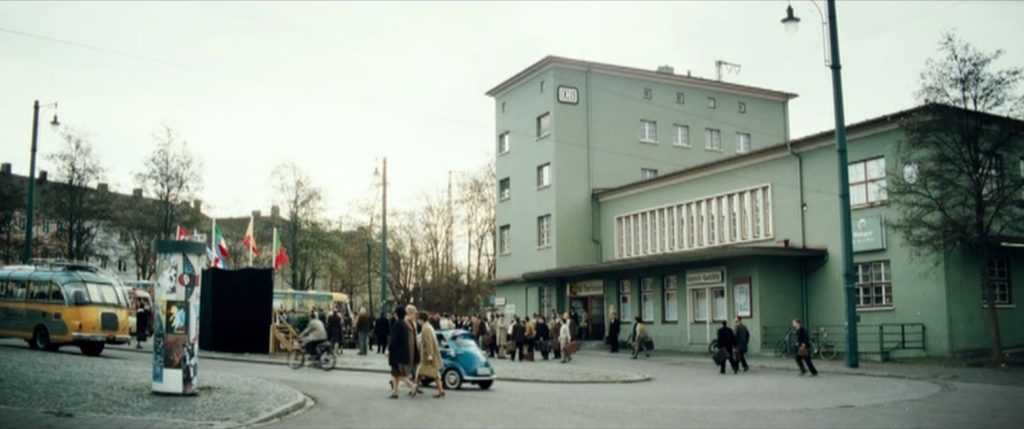
The slight sense of disorientation created by the montage is soon crystallized into a direct confrontation marked as a situation of misunderstanding: the gibberish speech given by a local politician whom the Turkish guest workers cannot understand. His choppy manner of speaking complements and reinforces the music’s focus on percussion, establishing a clear contrast to the foregrounding of string instruments in the scenes which take place in Turkey. As I want to stress, misunderstanding is not experienced as a problem of cultural difference, but in a mode of comedy that is heavily overdetermined in a (film) historical perspective, referencing Chaplin as well as the Third Reich (Figs. 3–4). The film constructs history through the way its audience embodies the aesthetic experience of watching movies, and through their ability to gauge the similarities and differences between them (for example, comparing the highly stylized staging and acting in The Great Dictator with the more naturalistic setting and almost jovial attitude of the politician in Almanya—realizing the comparison as an experiential difference). In this sense, we can understand the audience as a medium for these experiences and their actualization.
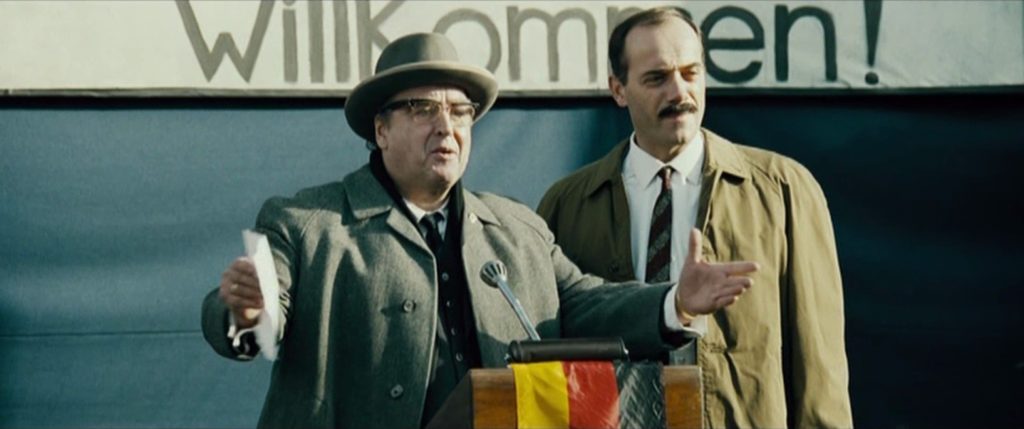

The gibberish speech completes the modal transition, which the film carries out parallel to the change of setting from Turkey to Germany: from the melodramatic mode characterizing Hüseyin’s departure to the mode of comedy. With this transition, the mode of affectively involving the audience also transitions: instead of the heavy legato—the stretching of time—we now are faced with a light staccato, and with a focus on the short, witty punch line. Silent, introverted mourning is replaced by an almost grotesquely over-determined speech act which implies a collective audience. As Greifenstein and Kappelhoff write, emphasizing the contrast between melodramatic and comedic stagings of time:
The melodramatic staging makes it possible to experience loss and irretrievability not only in the context of the narrative, but it shows this to be subsequently reflected in the spectator’s sense of time, through which time itself becomes the protagonist of the activity of sensing. […] In opposition to the extended unfolding, to the staging of a subjective perception in melodrama, […] laughing forms a quite different temporality. Rapidly exchanged verbal sparring emerges as the temporal form of a film composition […]. The movement figure in comedy does not stage a subjective sensation, but a collective vibration or resonance with one another: a we-feeling or a process of synchronizing different subjectivities […]. (36–37)
The difference between Turkey and Germany is realized first and foremost as the perception of a difference in the manner in which the spectator is addressed—prior to any question of representation. It is at this level that the question of how community is lived and experienced primarily becomes relevant: While the staging in Turkey turns every outward movement into the expression of an interior emotional state, the staging in Germany focuses on the choreography of figures in space, emphasizing harmony as well as discord. The modal transition also evokes a sense of the historicity of this staging, not only by referring to Chaplin (Fig. 4), but also by using a distinct color palette corresponding to the way historical events are routinely staged in German television.
After the gibberish speech, the figure of anticlimax (“figure” in the sense of an audiovisual rhetoric) is repeated in a more emphatic, though still humorous manner when Hüseyin, lured by a solicitor, is led to a pitiful little truck hidden behind an impressive bus—a typical sight gag reminiscent of silent film comedy. This figure of anticlimax is now openly interpreted as a feeling of disappointment and at the same time becomes fixed as a comical punchline. This punchline registers not only in the contrast between the bus and the truck, but is the result of an audiovisual composition that also includes a downbeat emphasis in the music and in Hüseyin’s facial expression—the sinking of the corners of his mouth. The arrival in Germany is therefore dually framed: on the one hand, as a modal transition from melodrama to comedy—simultaneously opening up a historical dimension, and on the other hand, as the disappointment of expectations.
This double framing characterizes the film’s core strategy of affectively engaging its audience. The flashbacks are constructed as tilting figures, permanently confronting the “official” version of history with the family’s personal experience. This confrontation is carried out over a wide range of generic forms whose affective modalities allow the audience to distinguish the level of the past from the level of the present by their qualities of experience. The past is often staged almost like a fairy tale. This particular way of addressing the audience is made all the more relevant by the fact that the family’s story is narrated to a small boy, the youngest member of the family, who most clearly articulates the film’s central conflict: “What are we anyway? Germans or Turks?”
The figure of the child fulfills a double function: firstly, the film’s narrative conflict—the question of belonging—is concentrated in his contested position between Germany and Turkey (for example, his birthplace is not even on the map hanging in his classroom). Secondly, the film’s two temporal layers are woven together with regard to his experiential perspective. This emphasis on a child’s perspective is even more prominent in the next example: a second flashback which transfers the feeling of disappointment staged in the first scene to a child’s experience of a German Christmas celebration.
The flashback details the family’s first Christmas in Germany. It stages the mismatch between the children’s desire for an ideal gift giving and the mother’s hopeless attempts to recreate the perfect image that has been built up by advertisements and imagination. The flashback begins with a shot/reverse shot montage reconstructing the siblings’ covetous gaze into the shop’s display window where a nativity scene is arranged. This back-and-forth movement in the montage is soon complemented by the insertion of seemingly ʻauthenticʼ home movie footage which on the one hand directly connects to the display window, and on the other hand demonstrates the ideal dramaturgy of a Christmas gift giving: the opening of doors is visually and verbally foregrounded, followed by a gift paradise in familial harmony (Figs. 5–6).
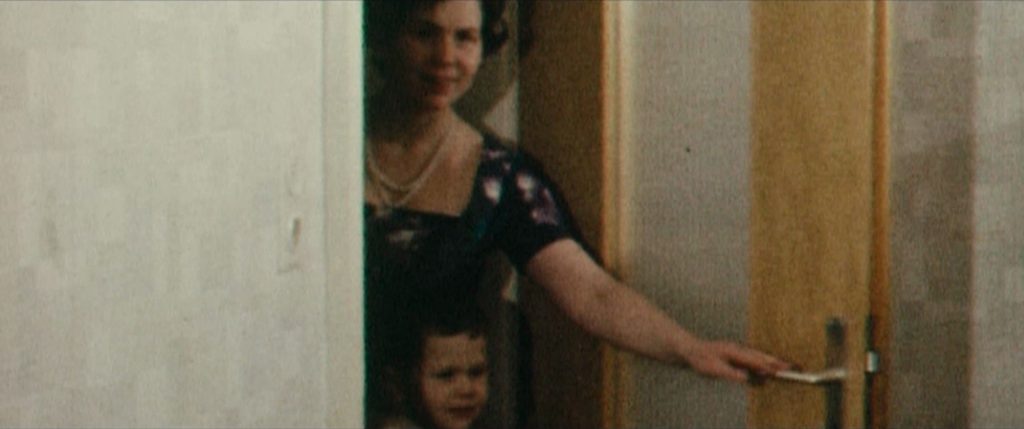
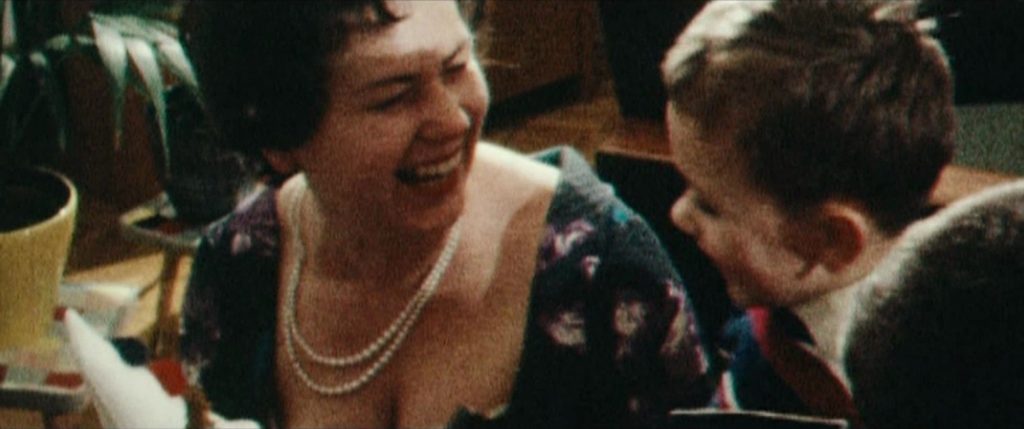
In an almost exact mirroring, the opening of the door is then transformed into the opening of presents. All this is held together by a Christmas carol sung in the same gibberish speech spoken by all German characters (“plüng ding dong plüngelüngelüng…” instead of “Kling Glöckchen klingelingeling”). This introduces an ironic perspective rendering the fantasy of a perfect Christmas recognizable as such.
The seamlessly integrated rhythm of movements becomes stuck at the exact moment when the protagonist family attempts to transpose this fantasy onto their circumstances. The children beg for their “first Christmas,” and the mother gives in. Significantly, the rhythm is broken by her revealing the presents too early—a pointed violation of the ideal dramaturgy of expectation which Christmas is built on. This ideal dramaturgy is then completely ruined when instead of an impressive tree, the mother reveals a puny little sapling (Fig. 7), a reveal resulting in the pronounced sagging of smiles.
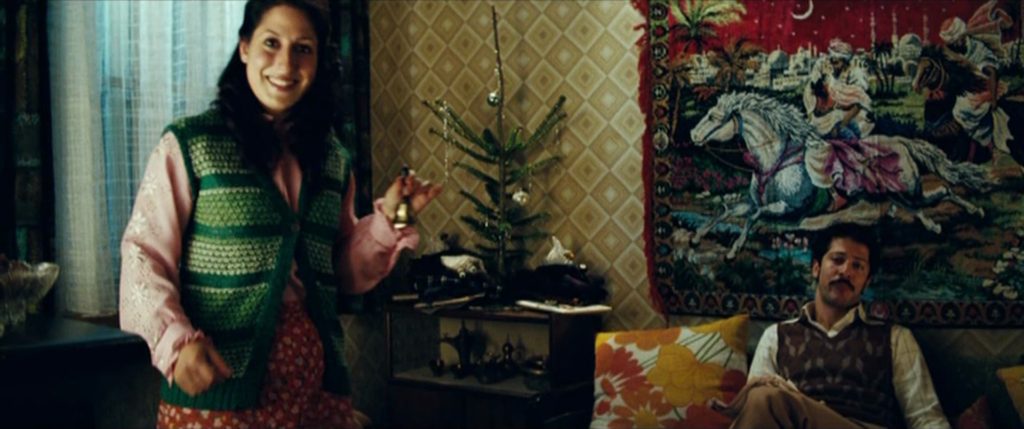
The images of the home movies situate the ideal case of this dramaturgy in a fantasy of the West German middle class in the 1960s or 70s. They not only date the flashback, but also invoke the shared imagination of an emphatically West German audience. That is to say, the film addresses its audience as sharing these fantasies of Christmas and understanding itself, through this sharing, as a community—irrespective of the actual, empirical spectator. At the same time, the film stages the failure of this fiction of community by adding a contrasting perspective. In this way, the flashbacks are shot through again and again with historic footage. The flashbacks become a tilting figure, a chiastic construction which can be folded either way (as with the language reversal). Both sides of this chiasmus—Turkish and German—are linked together in the present of the Turkish-German family.
Migration to Germany is made accessible as an affective experience, namely as a dramaturgy of disappointment. This dramaturgy translates the relation between display window and gift giving into a temporal parcours. It is this description (making migration accessible as an aesthetic experience) that evokes a specific “sense of commonality”: a feeling of having something in common. This is achieved through the appropriation of widely disseminated expressive patterns. For example, the sight gag (the reveal of the little sapling) refers back to a form of silent film comedy (more specifically, to Chaplin). This sight gag operates as a leitmotif throughout the film, already marking Hüseyin’s arrival in Germany and then gradually accumulating meaning and affective power. Ultimately, this device is emphatically inverted when the family arrives at the house that the grandfather (who has, in the meantime, died on the trip) has purchased in Turkey.
The family reaches the house only to find that it consists of nothing more than a façade. However, this time, their expectations are not undermined, but overwhelmed: Instead of opening onto a living room, the door opens onto the Turkish landscape in a majestic panorama (Figs. 8–10).
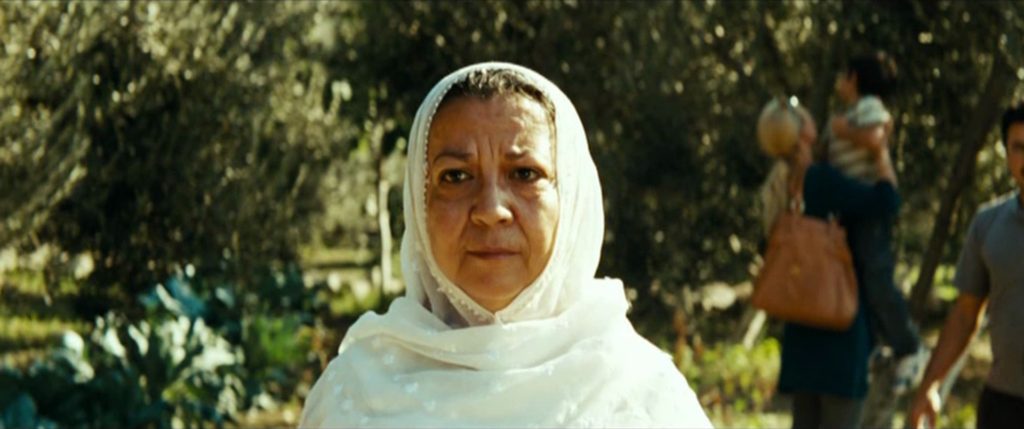
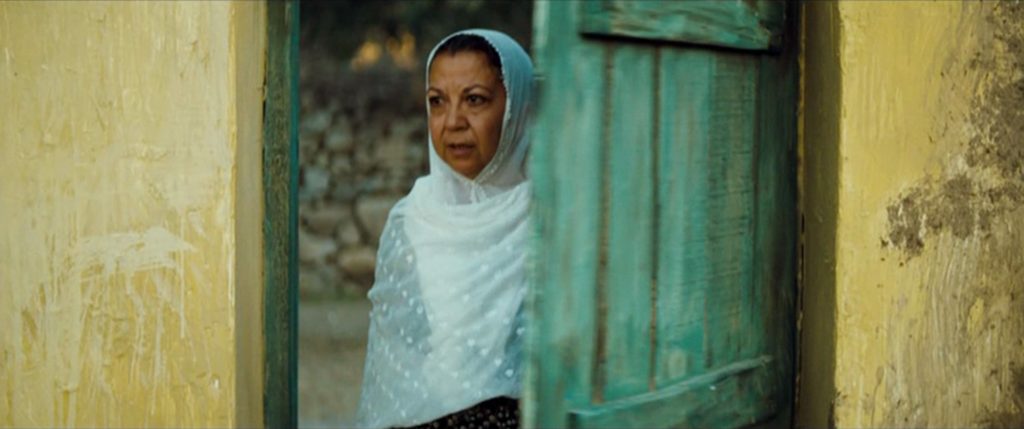
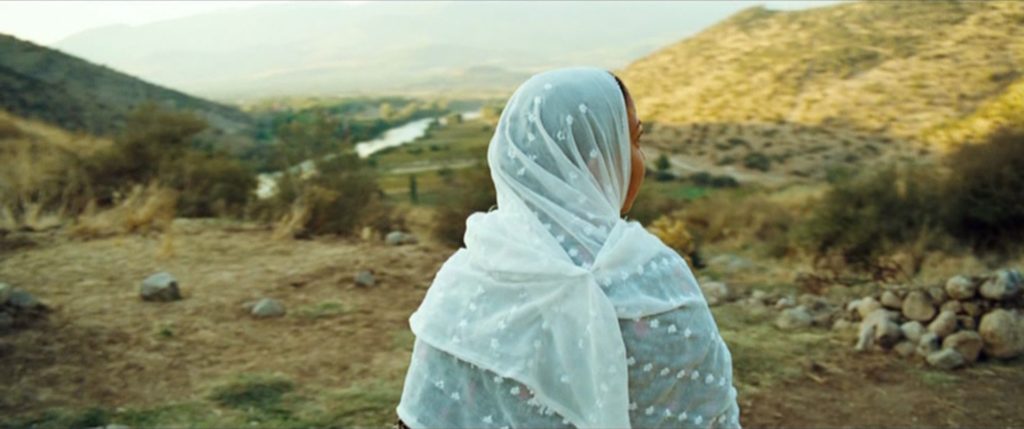
The sight gag is here transformed from a form of comedy into one of melodrama, and consequently changes its function within the film’s poetics of affect: It is now charged with the whole weight of lived history and lived disappointments accumulated over the course of the film’s permanent alternation between present and past.
At this point, the film again changes its field of reference. It no longer appropriates classical Hollywood, but expressive patterns from Turkish melodrama of the 1970s and 1980s—mirroring the melodramatic scenes of Hüseyin’s departure from the beginning of the film. Instead of ironically referring to a fantasy of capitalism, the sight gag now addresses a shared access to a specific emotional repertoire (dominated by nostalgia and melancholy) preserved in a memory of going to the cinema and spending afternoons in front of the TV. With this repurposing, the sight gag aims no longer at the punchline of disappointment, but at the almost miraculous resolution of a painful family chronicle. This resolution connects past and present with regard to the Turkish landscape onto which the sight gag (in its last variation) opens the audience’s view.
The gag is thus not only appropriated but itself becomes a leitmotif, repurposed according to the needs of the film’s affect dramaturgy and its spectatorial address. This provides a paradigmatic example of the way in which the analysis of tactical appropriations—of the discursive intersections and bifurcations of cinematic images—can serve to examine the modulation of a cinematic sense of commonality.
A Fragile Feeling of “Us”
This analysis demonstrates that what the film produces in terms of common reference points is the affective involvement of its audience. It is on this level—not on the level of representation—that films of “Turkish-German cinema” can be conceived of as a genre, with the precise sense of the term “genre” still to be developed. Almanya unfolds a cinematic worldview, a description of the world where identities and belongings are projected as affective relations. This affective involvement is first laid out in the film itself, as a space of experience. Spectators are then involved in the creation of this space via their own affective relations with the world. In the case of Almanya, the references of this space of experience range from road movies (Little Miss Sunshine [Jonathan Dayton, Valerie Faris 2006] is an obvious model for the staging of the family trip) to European art-house (notably the films of Jean-Pierre Jeunet), from classical Hollywood, advertisements, and Turkish melodrama (e.g., Sultan [Kartal Tibet 1978]) to the reenactment of historical documentary footage (e.g., a photo of the millionth “guest worker”). Each time, it is not about recognizing the exact reference, but about realizing, with one’s own body, a mode of affective involvement. As noted above, the film addresses its audience as the medium of shared experiences with regard to this space—it constructs (film) history through the way images, acting styles, or ways of staging landscapes are embodied by spectators in terms of aesthetic experience, establishing the potential common ground for a shared sense of the world. This address is in turn realized on the side of the spectators as a perceived gauging between personal deviation and accord with this experience. A wide range of reactions is made possible because the film makes this experience accessible from multiple perspectives—perspectives of irony, comedy, melodrama, and horror.
In this sense, the staging of community and identity as a fragile feeling of “us” characterizes the film. This feeling is only accessible in its fragility, that is, in the multi-perspectivity of the film’s staging. It dissolves the existing attributions of identity like “Turkish,” “German,” or “Turkish-German.” There is no final answer to the question “How does arriving feel?”; the answer remains immanent in the multiplicity of perspectives and is actualized with each new act of film viewing. It is for precisely this reason that “arriving” can serve as a heuristic category for an exploration of generic dimensions of films grouped under the label of “Turkish-German cinema.” Building from concrete analysis, we can examine how other films dealing with the theme of arrival—e.g., Lola + Bilidikid (Kutluğ Ataman 1998), Knallhart (Tough Enough, Detlev Buck 2006), or Abgebrannt (Burn Out, Verena S. Freytag 2011) —stage it as an affective experience and how they relate to one another in doing so. The question then is no longer which one is more accurate, but rather how these affective experiences intervene into popular culture, into the affective economies of discourses on migration and integration. We are now in a position to address this question more thoroughly.
Genre and Circulation
In attempting to answer this question it is crucial, as I have already noted, to clarify the concept of genre. My analysis provides us with material to do so in more detail, as it demonstrates the functional relationship between genres and modalities—with modalities understood as “ways of perceiving the world, and […] the genres as trajectories through this shared territory of forms of experience” (Grotkopp & Kappelhoff 39). This way, the concept of genre becomes useful for addressing the question of how films describe the limits of commonality. It is important that such an understanding of genre emphatically contradicts the idea of a corpus of films. The model of a corpus leads research to look for common features that are already in place—features most easy to find on the level of “text” and representation. As Rick Altman observes:
A fundamental problem of genre studies stems from the ever-present desire for a stable and easily identifiable object of analysis. Ever simplifying, genre critics have […] [reduced] the notion of genre to a corpus of texts or to textual structure. We do better, I suggest, to treat genre as a complex situation, a concatenated series of events regularly repeated according to a recognizable pattern. For a genre to exist, a large number of texts must be produced, broadly distributed, exhibited to an extensive audience and received in a rather homogenous manner. […] Yet no isolated part of this process actually is the genre; instead, the genre lies somewhere in the overall circulation of meaning constitutive of the process. (84)
In previous research, “Turkish-German cinema” has been predominantly conceived of as a genre precisely in the sense rejected by Altman (cf. Berghahn, Burns, Rings). These approaches have looked for similarities on the level of representation to define their corpus. Such reliance on what is seemingly already fixed in the “texts” of a genre tends to ignore the act of film perception as an event: an encounter between screen and audience. It is this encounter that opens up the perspectives and possibilities Altman addresses with his conceptualization of genre.
However, because the “traditional” (Altman 84) conception of genre has most often been implicitly presupposed, this approach has not yet received sufficient problematization—the fundamental question of this essay has not yet been asked. In view of the dubiousness of the term “Turkish-German cinema,” it is necessary to carve out the generic dimension of the films which are typically grouped together under this label. According to Altman, generic dimensions lie in the “circulation of meaning” connecting films with each other and with their audiences. I add three modifications to this assessment: Firstly, I go beyond Altman by further refining this circulation to the audiovisual modulation of a “sense of commonality.” These films fulfill an “affect-organizing function” (Kappelhoff 2012, 44) for the dissemination and transformation of notions and beliefs about migration and integration. It is by circulating notions and beliefs like these that a society produces ideas of itself as a community. In this sense, “films about migrants in Germany” are always films about Germany—whatever the intentions of the filmmakers may be (contrary to Göktürk 344). Secondly, this conception demands focusing on processes of affecting and being affected—processes which ground Altman’s “constitution of meaning.” Thirdly, contrary to Altman, I understand the manner of production, distribution, and reception not as homogenous, but as the construction of a historical space of experience: a space that is built and transformed with every film and each act of film viewing as an ever-evolving and shifting net of references, associations, and re-evaluations. In this understanding, genre does not aim at the endless repetition of the same experiences, but at historically situating spectator subjects (cf. Grotkopp & Kappelhoff 33–34).
Hence, the question becomes not “What do these films have in common?” but rather “Which historical spaces of experience are brought into contact with each other by these films in order to produce forms of commonality?” This question rephrases Stanley Cavell’s well-known dictum about the comedies of remarriage: “[…] they are what they are in view of one another” (29). Instead of presupposing an external reference point or rule, genre is produced in the circulation of meaning between films and their audiences. In this perspective, Cavell’s “view” has to be understood as the activity of film viewing, or, more precisely, as the poiesis of media consumption producing a historical space of experience.
Conclusion: What can we share?
I would like to return here to de Certeau. From the perspective of appropriation, films like Almanya can only be described in the tension between hegemonic discourses and dissident deviations. It is for this reason that the concept is able to address the tension marked by the term “Turkish-German cinema” —between a discourse of identity politics which attempts to fix the meaning of Turkish-German, and a production of audiovisual images which deal with the resulting attributions.
De Certeau conceives of this production as “another production, called ʻconsumption.ʼ [Consumption] is devious, it is dispersed, but it insinuates itself everywhere, silently and almost invisibly, because it does not manifest itself through its own products, but rather through its ways of using the products imposed by a dominant economic order” (xii–xiii). He refers to this production as “poiesis:” an act of bringing forth. According to the approach proposed here, this poiesis is linked to an affective economy of circulating forms and images. Employing de Certeau’s model as a reference point for the relation between audience and cinematic image, we can understand this relation as a poiesis of media consumption. De Certeau himself provides an example illustrating this idea: “the analysis of the images broadcast by television (representation) and of the time spent watching television (behavior) should be complemented by a study of what the cultural consumer ʻmakesʼ or ʻdoesʼ during this time and with these images” (xii).
Aside from the issue of representation, the important distinction introduced here lies between the practice of watching television and the poiesis of consumption as an act of bringing forth something new. If we understand the act of film viewing merely as a practice, it is hard to locate its transformational potential. This is why we have to focus on the aspect of encounter between screen and audience. The question posed by de Certeau— “What does the consumer fabricate?” —can be answered thusly: The consumer produces images. Cinematic images are not artifacts, they do not exist without an audience to appropriate and deal with them in their own way, making aesthetic judgments, establishing connections with other images, imagining possible continuations, etc.
As de Certeau is quick to point out, this production of consumption does not mean individual reception. Rather, he describes ways of dealing with commodities by which the individual is produced in relation to a primary dimension of collectivity. Thus, spectators can experience themselves as part of a collective, which emphatically does not coincide with society as a whole (cf. Altman 156–165) but rather is characterized by several degrees of dissent. This kind of community, defined more precisely as Rorty’s “sense of commonality,” is neither constituted by individuals nor as a preformed concept of identity. It is the possibility of experience opened up by the act of appropriation in seeing and hearing a film. Film viewing as the bringing forth of new images therefore means the construction of new spaces of experience: the creation of audiovisual worlds from ever new, each time specific perspectives. Almanya describes immigration to Germany by arranging an encounter between classical Hollywood, road movies, German home movies, and Turkish melodramas. Such a perspective in turn designates a position with regard to the world in which the films as well as the spectators move.
This act of positioning with regard to an audiovisual economy precedes any talk about cultural identity, about being German or Turkish. Not only that, it radically complicates such discussion. It seems much more necessary to examine how the fragility of a sense of commonality invokes and activates a generic dimension of the films in question: How do they deal with this fragility, how do they modulate and transform it, and how do they relate to each other while doing so? Provided with answers to these questions we might be able to describe how such films work toward what de Certeau calls a “therapeutics for deteriorating social relations” (xxiv), opening up moderately or boldly dissenting spaces of experience for their audiences. From this perspective, “Turkish-German cinema” has not yet found a new definition, and if a definition can be found, it cannot consist in simply demarcating a new corpus (although a re-modeling of the corpus is advisable). Rather, it would consist in describing the driving force behind the creation of new films—a conflict or pathos pointing to an unresolved disagreement at the limits of the political community. While the approach put forward in this paper focuses on the processual nature of genre, that is, the creation of relations and intersections, and not on the demarcation of borders, this lack of a new definition is not a coincidence. Describing the specific pathos of Turkish-German cinema, the constitutive conflict it reworks and redefines in terms of affective experience, cannot be the starting point of our investigation. Rather, it should be its goal. We cannot derive this pathos from sources external to the films, e.g., from the biographical and social fact of migration, because we do not share “the” experience of migration. What we potentially share is the experience of being a consumer among other consumers—the experience of a spectator in the cinema.[2]

Works Cited
Abel, Marco. “The Minor Cinema of Thomas Arslan: A Prolegomenon.” Hake and Mennel, pp. 44–55.
Altman, Rick. Film/Genre. British Film Institute, 1999.
Bakels, Jan-Hendrik; Hermann Kappelhoff. “Das Zuschauergefühl: Möglichkeiten qualitativer Medienanalyse.” Zeitschrift für Medienwissenschaft, no. 5, 2011, pp. 78–95.
Berghahn, Daniela. “From Turkish greengrocer to drag queen: reassessing patriarchy in recent
Turkish-German coming-of-age films.” New Cinemas: Journal of Contemporary Film, vol. 7, no. 1, 2009, pp. 55–69.
Burns, Rob. “Towards a Cinema of Cultural Hybridity: Turkish-German Filmmakers and the Representation of Alterity.” Debatte, vol. 15, no. 1, 2007, pp. 3–24.
Cavell, Stanley. Pursuits of Happiness: The Hollywood Comedy of Remarriage. Harvard University Press, 1981.
De Certeau, Michel. The Practice of Everyday Life. University of California Press, 1988.
El Hissy, Maha. Getürkte Türken: Karnevaleske Stilmittel im Theater, Kabarett und
Film deutsch-türkischer Künstlerinnen und Künstler. Transcript, 2012.
Elsaesser, Thomas. European Cinema: Face to Face with Hollywood. Amsterdam University Press, 2005.
Fincham, Victoria. “Violence, Sexuality and the Family: Identity ‘Within and Beyond Turkish-German Parameters’ in Fatih Akın’s Gegen die Wand, Kutluğ Ataman’s Lola + Bilidikid and Anno Saul’s Kebab Connection.” German as a Foreign Language, no. 1, 2008, pp. 40–72.
Gledhill, Christine. “Rethinking Genre.” Reinventing Film Studies, edited by Christine Gledhill and Linda Williams, Arnold, 2000, pp. 221–243.
Greifenstein, Sarah; Hermann Kappelhoff. “Feeling Gloomy or Riding High: Timings of Melodrama and Comedy.” Timing of Affect: Epistemologies, Aesthetics, Politics, edited by Marie-Luise Angerer, Bernd Bösel, and Michaela Ott, Diaphanes, 2014, pp. 263–283.
Grotkopp, Matthias; Hermann Kappelhoff. “Film Genre and Modality: The incestuous Nature of Genre exemplified by the War Film.” In Praise of Cinematic Bastardy, edited by Sébastien Lefait and Philippe Ortoli, Cambridge Scholars Publishing, 2012, pp. 29–39.
Göktürk, Deniz. “Migration und Kino – Subnationale Mitleidskultur oder
transnationale Rollenspiele?” Interkulturelle Literatur in Deutschland: Ein Handbuch, edited by Carmine Chiellino, 2000, J. B. Metzler, pp. 329–347.
Hake, Sabine, and Barbara Mennel, editors. Turkish German Cinema in the New Millennium. Berghahn Books, 2012.
Horkheimer, Max; Theodor W. Adorno. Dialektik der Aufklärung [1944]. Fischer, 2003.
Kappelhoff, Hermann. “Die vierte Dimension des Bewegungsbildes: Das filmische Bild im Übergang zwischen individueller Leiblichkeit und kultureller Fantasie.” Audiovisuelle Emotionen: Emotionsdarstellung und Emotionsvermittlung durch audiovisuelle Medienangebote, edited by Anne Bartsch, Jens Eder, and Kathrin Fahlenbrach, 2007, Herbert von Halem Verlag, pp. 297–311.
Kappelhoff, Hermann. Realismus: Das Kino und die Politik des Ästhetischen, Vorwerk 8, 2008.
Kappelhoff, Hermann. “ʻSense of Community:ʼ Die filmische Komposition eines moralischen Gefühls.” Repräsentationen des Krieges: Emotionalisierungsstrategien in der Literatur und in den audiovisuellen Medien vom 18. bis zum 21. Jahrhundert, edited by Søren R. Fauth, Kasper Green Krejberg, and Jan Süselbeck, Wallstein Verlag, 2012, pp. 43–57.
Naficy, Hamid. An Accented Cinema: Exilic and Diasporic Filmmaking. Princeton University Press, 2001.
Neubauer, Jochen. Türkische Deutsche, Kanakster und Deutschländer: Identität und Fremdwahrnehmung in Film und Literatur: Fatih Akın, Thomas Arslan, Emine Sevgi Özdamar, Zafer Şenocak und Feridun Zaimoğlu. Königshausen & Neumann, 2011.
Prager, Brad. “ʻOnly the Wounded Honor Fightsʼ: Züli Aladağ’s Rage and the Drama of the Turkish German Perpetrator.” Hake and Mennel, pp. 109–120.
Rings, Guido. “Blurring or Shifting Boundaries? Concepts of Culture in Turkish-German Migrant Cinema.” German as a Foreign Language, no. 1, 2008, pp. 6–39.
Rorty, Richard. Achieving Our Country: Leftist Thought in Twentieth-Century America, Harvard University Press, 1998.
Sadigh, Parvin. “Integration zum Lachen.” Die Zeit, March 3rd, 2011, http://www.zeit.de/kultur/film/2011-03/almanya-film, downloaded March 19th, 2017.
Seeßlen, Georg. “Das Kino der doppelten Kulturen: Erster Streifzug durch ein unbekanntes Kino-Terrain.” epd film, no. 12, 2000, pp. 22–29.
Sobchack, Vivian. The Address of the Eye: A Phenomenology of Film Experience. Princeton University Press, 1992.
[1] This essay is based on research undertaken in a subproject of the Collaborative Research Center Affective Societies at the Freie Universität Berlin: http://www.sfb-affective-societies.de/en/teilprojekte/C/C06/index.html.
[2] Thanks to Nazlı Kilerci for this formulation!
